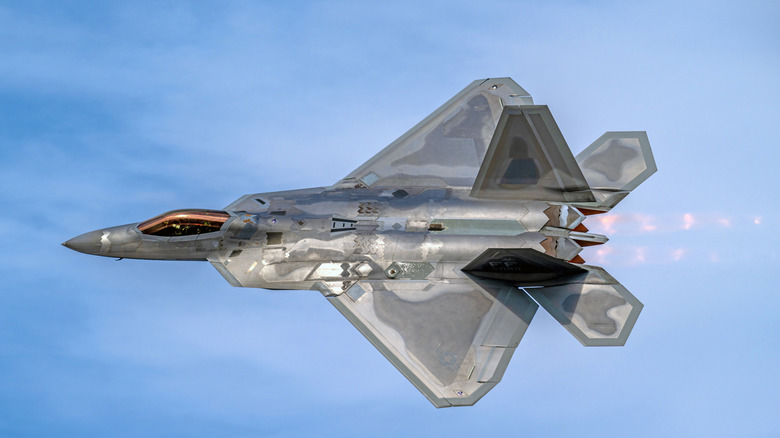How Long Can An F-22 Fly Without Refueling?
The F-22 Raptor is a unique fighter jet in many respects. It's a rare model that boasts the ability to supercruise, or achieve speeds in excess of Mach 1 without needing to engage its afterburners. Typically, fighter jets need to use their afterburners to break the sound barrier, thereby cutting their range significantly (the afterburners eat an awful lot of fuel) should they engage it. For that reason, it's very rare that supersonic jets such as fighters actually travel at supersonic speeds, particularly while cruising.
The F-22's ability to supercruise lends it significant versatility in operations, and also helps it perform for longer at higher speeds. There's always a limitation to the length an aircraft can stay in the air, though. Granted, the F-22 is also a model designed to be refueled mid-flight, by means of a KC-135 Stratotanker or other vessel equipped to provide this service, effectively making its range potentially limitless. As logistics dictate that there can't always be a an aerial refuel option available, though, the natural range of an aircraft is crucial to take into account.
The Raptor's range, equipped with both possible external fuel tanks, maxes out at approximately 1,850 miles. This means that, in a hypothetical and utterly implausible scenario in which it flew at supersonic speeds and with its afterburners engaged the whole time, it would be traveling at approximately Mach 2, which translates to 1,500 mph. In such a scenario, the aircraft could only fly for approximately an hour and a quarter without stopping to refuel. These numbers are not precise, of course, because there are so many variables to account for. That's a primary reason why jets equipped with afterburners don't blast them willy-nilly, but in less extreme situations, their endurance is rather different.
Different configurations and speeds of the F-22 drastically affect its flying time
Yes, it's fun at times to really open up your vehicle when you get the opportunity. There's always a time and a place, though, and when it comes to using the afterburners of the now-discontinued F-22, those times are very few and far between. Fighter jets don't spend much of their time at their very maximum speed, because it's impractical to do so. It's very variable, too. The F-22 is fastest nearer the peak of its performance ceiling (50,000 feet or more), where it can hit Mach 2 and above. The National Interest adds that, in contrast, "at sea level, where air molecules are packed more tightly, and the friction (resistance) between an airframe moving through those molecules is higher, the F-22 can reach speeds of Mach 1.21." This is the equivalent of 921 mph, which means that in this scenario, the F-22 could fly for approximately two hours if it started with its external tanks full. Again, this is assuming it's using the maximum fuel.
According to Holloman Air Force Base, an F-22 can fly for as long as two and half hours if it's flying higher (where there are fewer forces working against it), providing it doesn't engage its afterburners. Maj. Chris "Bandit" Bergtholdt, however, noted that, when it comes to the F-22, "Flying supersonic is part of our tactics and we have to train all of our pilots on that capability." For this reason, such training flights will inevitably have to travel faster than sound, and may do so up to around five times. Supercruise, however, still uses more fuel than subsonic flight, and this is why it's necessary to plan longer missions around refueling opportunities, whether in the air or on the ground.

